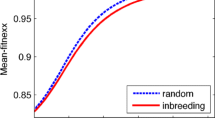Summary
We construct an inclusive fitness model to find the evolutionarily stable sex ratios in a partially sibmating diploid or haplodiploid population. We assume a constant rate of sibmating with inbred offspring incurring a fitness penalty which, under haplodiploidy, is only suffered by females. We construct a one-locus genetic model for the same problem and observe that when selection is weak it gives the same numerical results as the inclusive fitness model.
Similar content being viewed by others
References
Bulmer, M.G. (1986) Sex ratio theory in geographically structured populations.Heredity 56, 69–73.
Charlesworth, B. (1980) Models of kin selection. InEvolution of social behaviour: hypotheses and empirical tests, (H. Markl ed.) pp. 11–26. Verlag Chemie, Weinheim.
Charlesworth, D. and Charlesworth, B. (1981) Allocation of resources to male and female functions in hermaphrodites.Biol. J. Linn. Soc. 14, 57–74.
Christiansen, F.B. (1991) On conditions for evolutionary stability for a continuously varying character.Am. Nat. 138, 37–50.
Eshel, I. (1983) Evolutionary and continuous stability.J. Theor. Biol. 103, 99–111.
Falconer, D.S. (1989)Introduction to Quantitative Genetics, 3rd Ed. Longman Scientific & Technical, London, UK.
Fisher, R.A. (1930)The Genetical Theory of Natural Selection. Oxford University Press, Oxford, UK.
Frank, S.A. (1985) Hierarchical selection theory and ratios. II. On applying the theory, and a test with fig wasps.Evolution 39, 949–64.
Grafen, A. (1985) A geometric view of relatedness.Oxford Surveys Evol. Biol. 2, 28–89.
Hamilton, W.D. (1967) Extraordinary sex ratios.Science 156, 477–87.
Hamilton, W.D. (1972) Altruism and related phenomena, mainly in social insects.Ann. Rev. Ecol. Syst. 3, 192–232.
Hamilton, W.D. (1975) Innate social aptitudes of man: an approach from evolutionary biology. InBiosocial anthropology (R. Fox, ed.) pp. 133–55. John Wiley and Sons, New York, USA.
Hamilton, W.D. (1979) Wingless and fighting males in fig wasps and other insects. In (M.S. Blum and N.A. Blum eds)Sexual selection and reproductive competition in insects pp 167–220. Academic Press, New York, USA.
Herre, E.A. (1985) Sex ratio adjustment in fig wasps.Science 228, 896–8.
Kaitala, V. and Getz, W.M. (1992) Sex ratio genetics and the competitiveness of parasitic wasps.Bull. Math. Biol. 54, 295–311.
Maynard Smith, J. (1978)The Evolution of Sex. Cambridge University Press, Cambridge, UK.
Michod, R.E. and Hamilton, W.D. (1980) Coefficients of relatedness in sociobiology.Nature 288, 694–7.
Miller, P.S., Glasner, J. and Hedrick, P.W. (1993) Inbreeding depression and male-mating behaviour inDrosophila melanogaster.Genetica 88, 29–36.
Price, G.R. (1970) Selection and covariance.Nature 227, 520–1.
Taylor, P.D. (1981) Intra-sex and inter-sex sibling interactions as sex ratio determinants.Nature 291, 64–6.
Taylor, P.D. (1988) Inclusive fitness models with two sexes.Theor. Pop. Biol. 34, 145–68.
Taylor, P.D. (1989) Evolutionary stability in one-parameter models under weak selection.Theor. Pop. Biol. 36, 125–43.
Taylor, P.D. (1993) Female-biased sex ratios under local mate competition: an experimental confirmation.Evol. Ecol. 7; 306–8.
Taylor, P.D. (in press). Inclusive fitness arguments in genetic models of behaviour.J. Math. Biol.
Taylor, P.D. and Bulmer, M.G. (1980) Local mate competition and the sex ratio.J. Theor. Biol. 86; 409–19.
Taylor, P.D. and Getz, W.M. (1994) An inclusive fitness model for the evolutionary advantage of sibmating.Evol. Ecol. 8, 61–9.
Author information
Authors and Affiliations
Rights and permissions
About this article
Cite this article
Denver, K., Taylor, P.D. An inclusive fitness model for the sex ratio in a partially sibmating population with inbreeding cost. Evol Ecol 9, 318–327 (1995). https://doi.org/10.1007/BF01237777
Issue Date:
DOI: https://doi.org/10.1007/BF01237777




